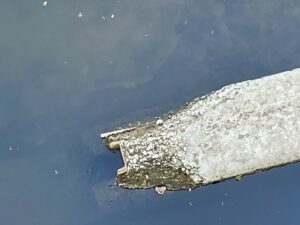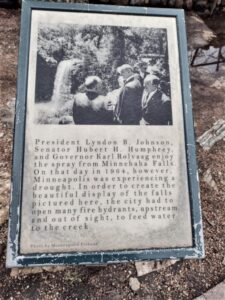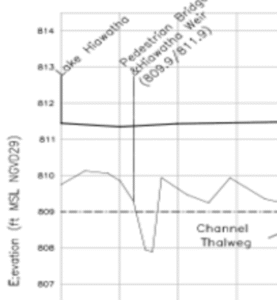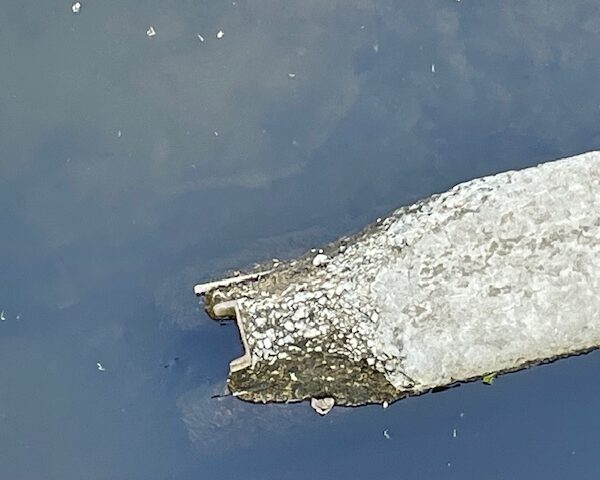
You can see the post holes in the dam that held back five feet of water from Lake Hiawatha from the pedestrian bridges over Minnehaha Creek at 27th Avenue
BY ED FELIEN
The Mayor’s race is the big one. After that, people notice candidates for City Council, and only after that, and only if they follow local government very closely, do they pay attention to Park Board candidates and candidates for the Board of Estimate and Taxation.
So far, it looks like there are only two candidates vying for the two seats on the BET, the incumbents, Steve Brandt and Samantha Gonzalez Pree-Stinson. Since there are no challengers, there’s not much to talk about there.
I asked candidates for the Park Board the following question:
“The Nokomis-Hiawatha Regional Park Master Plan calls for reduced pumping of water from the golf course which will eventually flood most of the area and cause flooded basements in the surrounding neighborhood. The Director of Planning for the Park Board claims a reduction in pumping will allow the area to return to its natural state. But flooding in  the area is a relatively recent phenomenon. In 1964, to impress his boss, Vice President Hubert Humphrey had the U S Corps of Army Engineers build a dam with a detachable weir that could be removed on Minnehaha Creek.
the area is a relatively recent phenomenon. In 1964, to impress his boss, Vice President Hubert Humphrey had the U S Corps of Army Engineers build a dam with a detachable weir that could be removed on Minnehaha Creek.
“It was a summer of drought. The creek had dried. But Humphrey, the former Mayor of Minneapolis, had the fire hydrants opened in the neighborhoods that drained through the storm sewers into Lake Hiawatha. This raised the water level of Lake Hiawatha by more than five feet. When LBJ’s plane landed he had the top portions of the weir removed and, in the midst of a drought, water gushed over Minnehaha Falls. There is a plaque at the bridge over the Falls to commemorate the Humphrey miracle.
“After the “Humphrey miracle,” my parents had a continuing flooded basement in their home at 4213 29th Avenue and eventually had to replace their foundation as a direct result of the consequent increase in the water table.
“Would you support removal of the Humphrey Dam at 27th Avenue?”
We received the following answers:

Kedar Deshpande
Kedar Deshpande:
“Dams reduce flooding, generate power and can benefit urban environments. Dams also alter ecosystems and can have negative effects on plants, wildlife and cities. If removing a dam could restore habitat and improve water quality without harming people and infrastructure, I would be supportive, but multiple agencies must also approve.”
Dan Engelhart:
“I am generally opposed to Dams, Removal of this Dam seems to me the be the most logical path forward to stop the pumping and keep the golf course as the legacy golf course it is- so that’s a tentative yes!”
Justin Cermak
“I think a new water solution is needed for the Hiawatha Golf Course and the Minneapolis watershed in general. Current proposals fail to meet any sort of clean water or groundwater solutions. I don’t even let my dog swim in the lakes or Minnehaha Creek.”

Dan Engelhart (with Isis)
Meg Forney:
“YES, if the Minnehaha Watershed Creek District does. The dam is not within the Minneapolis Park and Recreation Board system’s purview. It is doubtful the Minnehaha Creek Watershed District will support the dam’s removal since both they as well as I support the Hiawatha Links Project.”
Adam Schneider:
“Yes. I definitely support removal of the dam on Minnehaha Creek that is blocking water from leaving Lake Hiawatha.”
Michael Wilson, candidate At Large:
“The middle of the dam is already gone. Removing what is left of the dam would not change the creekbed highpoint at the outflow and would have no impact on the overall water level. I support the long-term plan for Hiawatha Golf Course, but this warrants more discussion with staff.”
I responded:
Thank you, Michael, for your response.

Adam Schneider
If, as you say, you believe removal of the dam would have no effect on the water level of the lake or on the water table for surrounding homes, then you would not be opposed to removing it, would you?
My reading of the Barr Engineering map suggests there would be at least a two-foot drop in the water level.

This profile seems to suggest there is at least a two foot high structure holding back water from Lake Hiawatha























Why focus on the dam? Why not just ask if they support modifying the creek to lower the water level?
The Barr Engineering report that you quoted explicitly states that the dam is not currently controlling the water level, and removing it alone would not change the lake level.
The chart that you cropped shows the control points near 28th and again at 30th. The report states that 2000 feet of creek bed would need to be modified (including the control points near 28th and 30th) to lower the lake level approximately 1 foot.